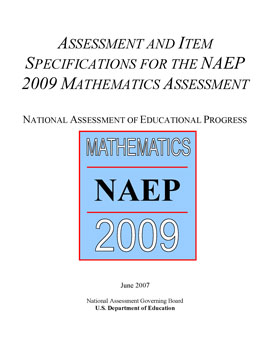
Assessment and Item Specifications for the NAEP 2009 Mathematics Assessment
Since 1973 the National Assessment of Educational Progress (NAEP) has gathered information about student achievement in mathematics. Results of these periodic assessments, produced in print and web-based formats, provide valuable information to a wide variety of audiences. They inform citizens about the nature of students’ comprehension of the subject, curriculum specialists about the level and nature of student achievement, and policymakers about factors related to schooling and its relationship to student proficiency in mathematics.
The NAEP assessment in mathematics is accomplished in two different ways. One assessment measures long-term trends in achievement among 9, 13, and 17-year old students using the same basic design each time. This unique measure has allowed for comparisons of students’ knowledge of mathematics since the assessment was first administered in 1973. The main NAEP assessment is administered at the national, state, and selected urban district levels. Results are reported on student achievement in grades 4, 8, and 12 at the national level and for grades 4 and 8 at the state and trial urban district level. The main NAEP assessment is based on a framework that can be updated periodically. The Assessment and Item Specifications for the NAEP 2009 Mathematics Assessment only reflects changes in grade 12 from 2005. Mathematics content objectives for grades 4 and 8 have not changed from 2005. Therefore, main NAEP trendlines from the early 1990’s can continue at 4th and 8th grades for the 2009 assessment. Taken together, the NAEP assessments provide a rich, broad, and deep picture of student mathematics achievement in the United States.

2009 Mathematics Frameworks Specification
Specifications describe the detailed blueprint used for constructing the assessment.